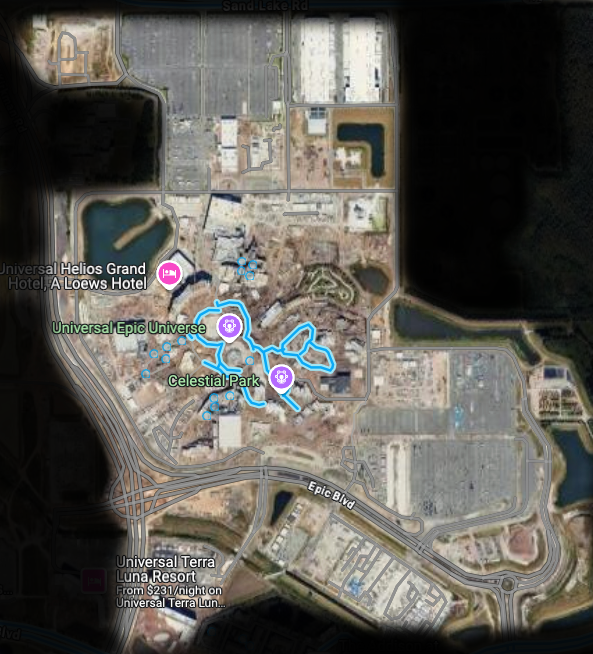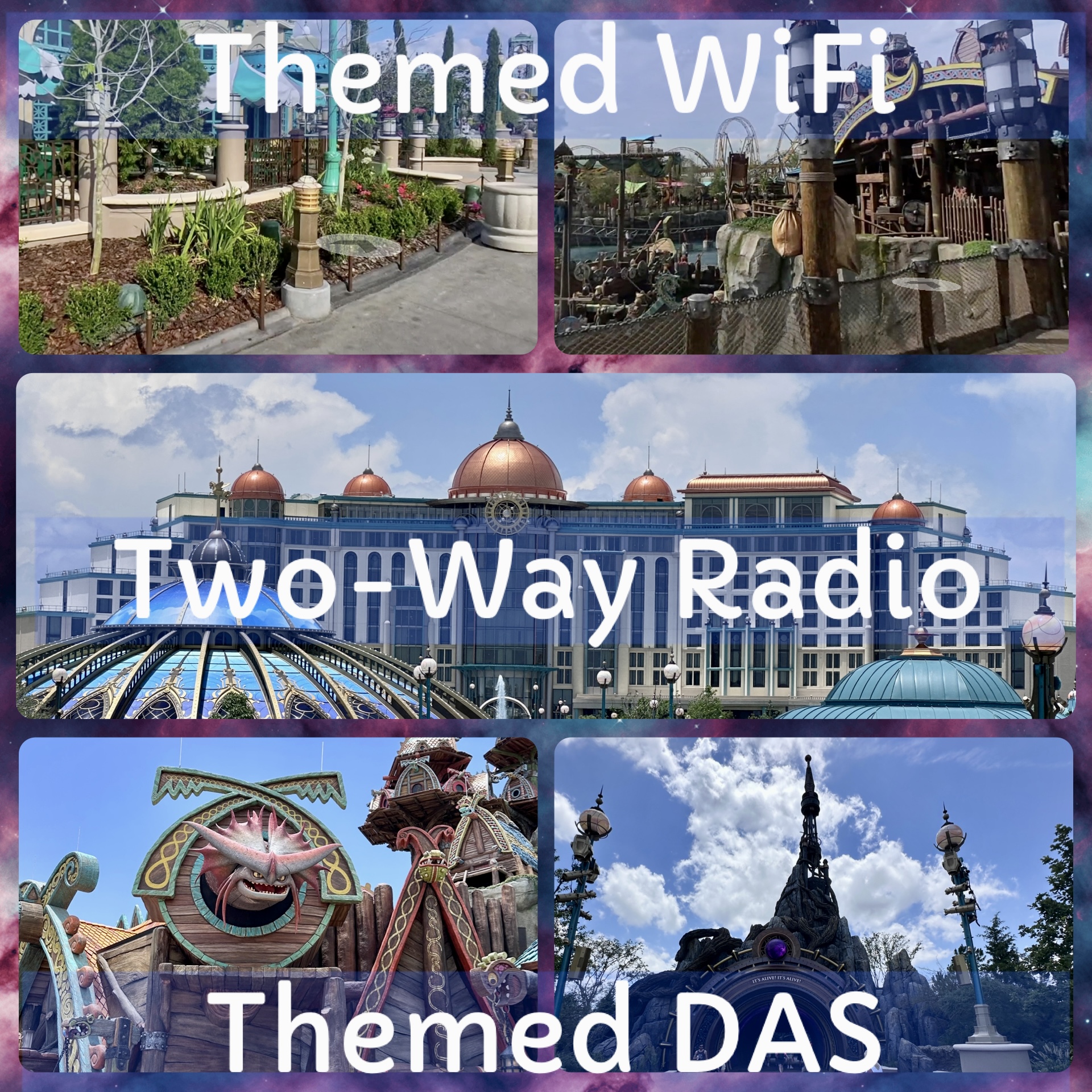Epic Universe Wireless & OT Audit
Wi‑Fi 6, DAS, two-way radio, E‑Stop Handpacks, Wireless Mics, Wireless DMX, and Emergency Responder Systems
Key Skills

Summary
When I stepped into my role as Parkwide Wireless Systems Manager in November 2023, Epic Universe had already been rising from the ground for nearly five years. The 750+ acre theme park campus was still taking shape—but its wireless systems were far from complete. Only about 10% of Wi‑Fi access points had been installed, temporary networks were incomplete, and no buildings had active Emergency Responder Radio Coverage (ERRC) systems. The project teams had deep rapport and well‑established rhythms. I joined at a critical inflection point—just 18 months from opening—charged with evaluating in‑progress designs, driving multimillion‑dollar installations to the finish line, and integrating into a veteran team already steeped in the project’s culture.
What followed wasn’t just a technical deployment—it was a trust‑building, deadline‑driven transformation of unfinished infrastructure into a resilient wireless backbone for guest experience, life safety, and operational readiness.
I was called upon to help Dragons soar, Monsters roar, and each visiting Wizard expand their lore—to bring Nintendo’s world to life with Mario and Donkey Kong, and give the Celestials a fantastic cosmos to explore. In short, my team and I had to make magic real—by orchestrating the invisible infrastructure of radio frequency systems, the so‑called ‘dark magic’ behind modern themed experiences.
Project Narrative
Walking Into the Storm
When I first arrived on site, the scale of Epic Universe was awe‑inspiring—but its wireless infrastructure was skeletal. Construction was accelerating, yet most buildings lacked the conduit, power, and access pathways needed to support the complex systems ahead. Designs were already in motion. Equipment had been ordered. And contractors were ready to install. But I was just arriving. I had to quickly assess where things stood, identify critical gaps, and stay ahead of issues that could derail testing, onboarding, or operations. The margin for error was razor‑thin.
I walked floorplates in boots and hard hat, cross‑referencing RF layouts against physical realities, flagging mismatches, and resolving them before they became rework. This wasn’t a blank slate—it was a moving target. My job was to navigate the chaos without stalling momentum—and still shape the outcome before the concrete dried.

Bridging Worlds, Building Trust
One of the most complex challenges wasn’t technical—it was cultural. The project teams had worked together for years, developing mutual trust and finely tuned working rhythms. As the new lead for wireless systems, I couldn’t simply dictate changes; I had to earn buy‑in. I leaned heavily on my years in themed entertainment at Disney and the technical rigor I developed through DISA and active duty in the U.S. Navy. That background gave me both the credibility and humility to assess quickly, act decisively, and lead collaboratively.
Rather than disrupt the work already in progress, I supported it. I cleared longstanding roadblocks that had delayed progress for weeks and empowered the existing wireless team to move forward without interruption. I listened first, removed friction, and focused on building momentum. I made it a point to learn everyone’s language—construction, creative, IT, and security—and to translate the wireless strategy into terms that aligned with each discipline’s priorities. That empathy, paired with deep technical knowledge, opened doors. Within weeks, I went from being “the new guy” to a trusted partner—someone teams called when they needed answers, clarity, or support. Once earned, trust became the fuel that turned coordination into momentum.
Engineering the Invisible
Wireless systems are unlike traditional infrastructure. They must be designed both on paper and in the air, shaped by steel, concrete, and motion. I led the full lifecycle of wireless deployment—conducting QA inspections, validating AP placement, and orchestrating field testing across Wi‑Fi 6, BLE, LoRaWAN, and Motorola two‑way systems. Early on, I walked the site alongside the Parks Technology Infrastructure Responsible Individuals (PTI‑RIs), not only to verify conduit and cable readiness but to earn their trust and identify where I could have the greatest impact. That partnership ensured seamless coordination across disciplines—and revealed where support was most needed.
I also expanded temporary wireless coverage using Peplink and MiMosa point‑to‑point (PTP) networks, essential for jobsite communications and safety operations. In one instance, a newly deployed PTP node enabled a worker to place a Wi‑Fi call after his colleague suffered a serious hand injury. Without that coverage, they would’ve had to leave the scene to find a signal—delaying the emergency response.
These systems weren’t just spec‑sheet items—they were silent guardians of safety.
Every network—permanent or temporary—had to meet strict criteria for availability, resilience, corporate cybersecurity governance, and regulatory compliance. I coordinated FCC licensing and spectrum usage across a dense, multi‑layered frequency environment to mitigate interference.
This wasn’t just infrastructure—it was the real‑time orchestration of dynamic, interdependent layers of signal, space, and safety.
Delivery Without Compromise
As the park neared operational turnover, my focus shifted from deployment to assurance. I reviewed scopes of work, led walkouts, and documented field conditions to resolve issues before they became failures. Partnering with UPT Wireless Engineering and Universal’s Technical Services—the teams responsible for long‑term operations—I facilitated site‑level testing, including Wi‑Fi surveys using Ekahau, two‑way radio analysis with a FieldFox spectrum analyzer, and integrated readiness walkthroughs with future owners.
At every step, I emphasized clarity and continuity: how systems were designed, how they were validated, and how they would be supported once the builders stepped away. I delivered stakeholder briefings and final turnover documentation for Hotel Operations, Park Operations, Security, and Wireless Engineering—including not just the immaculate records required for audit, but also desktop quick‑reference guides I created proactively. They weren’t required. But I knew future operators would need them when no one else was around. I didn’t just deliver wireless systems—I delivered confidence. Systems ready to support thousands of daily guests and hundreds of staff. Not just on paper, but in real life.
The Hidden Architecture of Magic
Epic Universe wasn’t just a construction project—it was a living system coming online in real time. My role was to ensure its wireless backbone was not only complete, but resilient, intuitive, and trusted from day one. That meant aligning a complex web of partners—including AT&T, Verizon, T‑Mobile, Crown Castle, CTS, WWT, HNM, Motorola, Skeene’s Technology Solutions (STS), West Networks, Summit Broadband, and CBRS providers—into a unified deployment strategy. I brought clarity where there was friction, empowered internal teams, and delivered results without disrupting the creative rhythm of the project.
What I left behind aren’t just finished systems—they are a foundation that enables security, operations, and storytelling to flow together seamlessly. And while guests may never see the systems we built, they’ll feel the impact every time a show launches on cue, a call for help is answered instantly, or a connection just works—quietly, flawlessly, and exactly when it matters most.
Epic Universe | Parkwide Systems | Wireless Team
The Team Behind the RF Magic
Celebrating the first day non‑project Team Members (TMs) pass through the portals and feel the magic that 400+ UC TMs & thousands of contractors brought to life.
Key Achievements – Epic Universe
- Directed the Parkwide Systems team’s wireless strategy for Universal’s 750+ acre Epic Universe campus—including 3 resort hotels and extensive back-of-house areas.
- Led the full lifecycle of wireless infrastructure across Wi‑Fi 6, cellular DAS, BLE, LoRaWAN, and two-way radio systems—spanning design, test & adjust, and turnover.
- Engineered and deployed redundant MiMosa and Peplink point-to-point networks to support life safety systems, construction-phase testing, and 24/7 site-wide security comms.
- Coordinated FCC licensing and RF spectrum usage across Wi‑Fi, LoRaWAN, BLE, DAS, and Motorola systems—resolving interference and ensuring regulatory compliance.
- Resolved legacy deployment blockers by empowering existing team members and earning trust across creative, engineering, operations, and security groups.
- Performed site QA, walkthroughs, field testing, and documentation reviews alongside PTI-RIs to ensure quality, code compliance, and vendor accountability.
- Partnered with AT&T, Verizon, T‑Mobile, Crown Castle, CTS, WWT, HNM, Motorola, STS, West Networks, Summit Broadband, and CBRS providers to deliver on schedule.
- Delivered final stakeholder briefings and turnover documentation to Hotel Operations, Park Operations, Security, and Wireless Engineering—including quick-reference guides created proactively for post-handover success.
We Have Dragons — And You Can See Them
In this 19-minute, 26-second video, you’ll experience the full performance of “Untrainable,” the signature live show from Epic Universe’s Isle of Berk. Behind the fire-breathing dragons and emotionally driven performances is a foundation of wireless systems that bring the experience to life—and ensure the safety of everyone involved.
The wireless infrastructure I supported included:
- Safety monitoring systems for animatronic and flying dragons
- Wireless DMX control for synchronized lighting and effects
- Wireless microphones for actors and musicians
- Wireless E-Stop handpacks for emergency response and tech cueing
- Venue-wide support for Wi‑Fi 6, Bluetooth, Cellular DAS, and Emergency Responder Radio Coverage (ERRC)
Video courtesy of Universal Parks News Today on YouTube.
The Story Continues...
Contact
Email: guy.t.teets@gmail.com